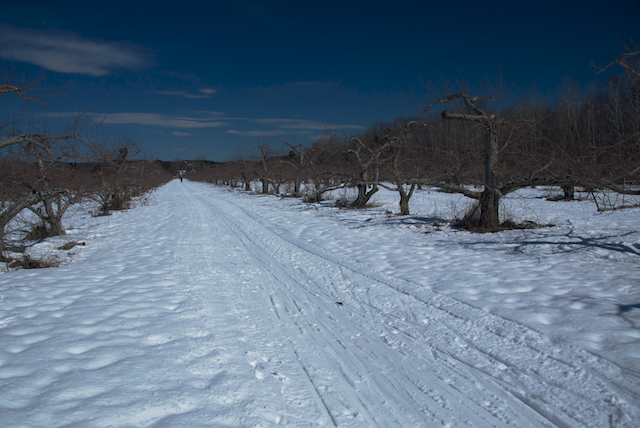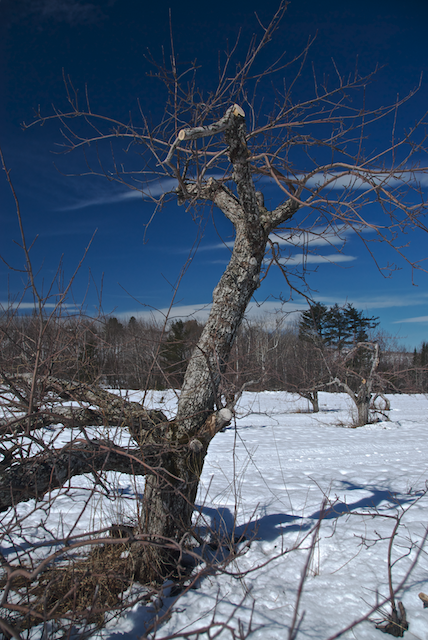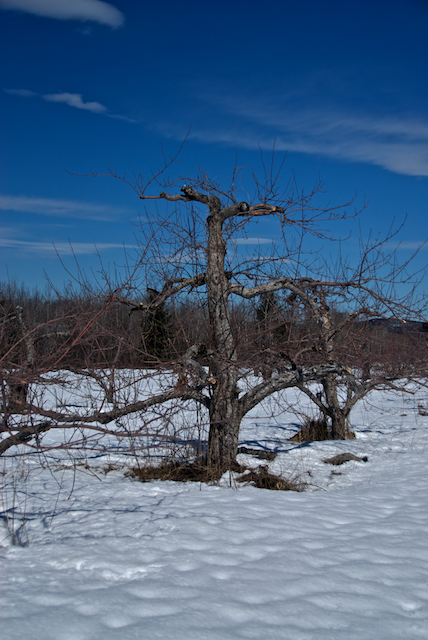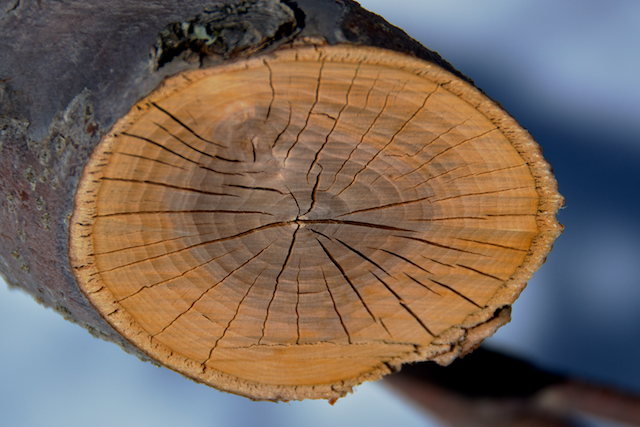28 Apr 2011
Now that winter is over and I am reviewing (and largely discarding) the snow photos I took, I am struck both by how many there are (reflecting lots of cold shoots) and how disappointingly few are worth keeping. I think I see a hopeful trend towards improvement over the season. Here’s a summary of what I have learned this season. It may benefit someone else - but it is mostly to get me started next winter where I ended this spring. The photos are from one of my last skis of the season.

Equipment
- Carrying case. A backpack works poorly. Even an expensive day pack for winter sports. I had to stop skiing and take it off to get the camera out before any shot, and then pack up again after the shot - a tremendous disincentive. In addition, it invariably tipped over on the snow. The ThinkTank digital holster I got for hiking last year worked great for skiing as well. The camera is easily accessible, close to the body for good weight distribution and balance, well padded, and easy to ski with. The only drawback is that the backpack was useful for carrying spare gear, extra clothes and the like, so for long expeditions I wear both (as I do when hiking).
- Weather gear for the camera. The Vortex storm jacket works great in both heavy wet snow, fine blowing snow, and sleet.
- Carry an extra battery in a warm inner pocket. Nothing says ‘oh shit’ like a dead battery and a perfectly lit subject.
- Don’t skimp on gloves. I found several I liked. One was Mountain Hardware Power Stretch. The Manzella fleece Cascade (warmest version) is tremendous. Another was a combination of Terramar Body Sensor liners in a warmer glove, taking the warmer layer off when pulling the hand out of the ski pole, keeping the liner on to take the photo. Perhaps next year I’ll try a pair of open finger gloves like this or this.
- Glasses. I need glasses to make setting changes on the camera. This is especially important when covering different terrain over a period of a number of hours skiing. Without glasses, i just can’t read the settings. And my glasses fog up when I ski. My temporary solution was to bring glasses and use them intermittently, but this is clearly not ideal.
- Make sure your pole straps are not too tight. They should be just snug enough to hold the outer glove layer securely while you slide your hands and liners out – and loose enough to let you slide your hands back in.
- Be careful about sunglasses. They are essential for being outdoors in the snow to prevent damage (and discomfort) to the eyes. If it is snowing - especially snowing hard - skiing without some form of eye protection is worse than not fun, it’s dangerous. (Trees and other obstacles move ,and the trail changes shape and direction when skiing with closed eyes. I swear.) The Rudy project product worked well and was the least pricey of the various options: (Would you believe $250 for some products?) And those great colors you stop to photograph? Make sure it isn’t an artifact from the glasses before you strip off lots of layers.
- If I dressed for photography, I was too hot for skiing or snowshoeing. If I dressed for skiing or snowshoeing, I was cold when taking pictures. I did not find a great solution for this, beyond accepting the need to make photo-ski days slow steady days and leave the power skiing for another day.
- Chemical hand warmers (we call the Grabbers) are absolutely necessary. Don’t leave home without them. Buy them in bulk.
- Have dry and thick driving gloves and a dry hat and a small hand towel in the car ready for when you come back, cold and wet.

Setting
- Wind. Open places are not good when it is windy. A wind speed that you might not notice in ordinary circumstances is the difference between cold and dangerous when it is 8 degrees and you are sweaty and take off your gloves and stand still for 15 minutes to take pictures.
- Snowstorms are fine, but they seem more photogenic than they are. And they are definitely harder to photograph than they seem. How does one capture wind, horizontal snow, and the effort of skiing in 18 inches of untracked powder?
- When you are skiing, don’t take off your skis and leave the trail for a photo. (This is what snowshoes are designed for.) You will be surprised multiple times, first by how deep the snow is, then by how hard it is to walk without falling down, and then by how hard it is to get your skis back on. Just be glad you weren’t surprised to find running water under the snow when you were getting close to the stream you wanted to photograph. (Yup.)
- Photo-skiing calls for a solo ski. Skiing companions quickly tire of waiting in the cold while you take yet another shot of snow on an old stump or rock wall.
Technique
- Acclimatize the camera for 15 minutes both when starting and when coming in. Condensation on the lens is not good for clarity, and condensation in teh camera is not good. Period.
- Don’t drink coffee or tea for several hours before you set out for a shoot, and still be prepared to have a full bladder 30 minutes after you start. (Every Nordic ski racer knows this.) When you go out in the cold, your peripheral capillary beds constrict to avoid losing warmth. This dumps circulating volume into the core, which the kidney interprets as a sudden volume load, which it obediently excretes.
- Shoot RAW (not jpeg) so you don’t have to worry about white balance (which would be the Shade setting on most cameras)
- Use a polarizing filter for the sky on a bright day. And most days are brighter than you think.
- Avoid the blues. Snow is bright white but cameras expect to see (and calibrate with) 18% medium gray. This is the light reflectivity of green grass or concrete. Because your meter is calculating based on a mythical standard, you will need to either overexpose by a factor of 1.5 or 2 (use manual mode and use 1-2 change in f stop) or use exposure compensation 1.5 - 2.0. (Eyes and brains are equipped with an awesome collection of autosettings and siletly and instantly equalize about 10 distinct camera zones and settings, ranging from a sunny day outside and 1/2000 to a well lit interior 1/8 (ISO 400, f/8).
- Bracketing helps. And is much easier than trying to take three different exposures with every shot. If you exposure bracket 1 or 1/2 f stops over and under, you greatly increase your chance of a good shot.
- Lying on the snow gives great results, but is best done with a thick blanket roll to lie on or pretty near the end of a shoot. Lying down and getting up in deep sow with skis or snowshoes on your feet and a camera in your hands is a challenge. And loose snow will find any gaps in your clothing.
- Histograms are your friend. Take a shot or two at your desired subject and look at the histogram, and then adjust settings and save yourself time in post processing, and distress when post processing doesn’t quite get you where you want to go.
- Which is better, a GND (graduated neutral density filter) filter or post-processing with photoshop or aperture? Post processing, hands down.

Wisdom, suggestions and alternatives would be delightful. Please add them in comments below.

Links to more on this topic:
